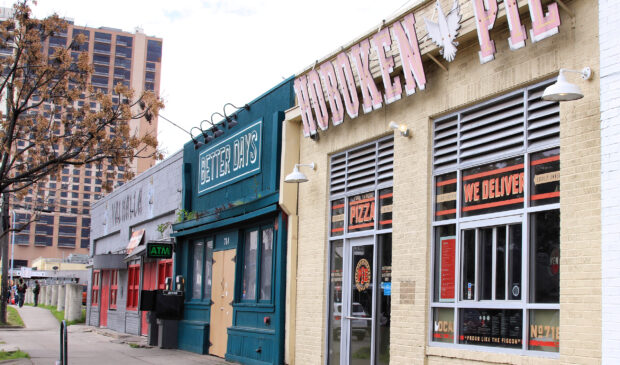Music Commission wants clubs, creative space required in Red River Cultural District
Wednesday, May 8, 2024 by
Chad Swiatecki The Music Commission wants the city to ensure that any new multistory development within the Red River Cultural District would need to provide discounted space for music venues or creative uses, without offering any density bonus incentives.
At Monday’s meeting, the commission opted to add provisions to a recommendation offered by Economic Development Department staff, which was originally intended to implement a “combining district” and density bonus program specifically for creative uses in new projects. That recommendation was approved along with language asking City Council to institute a restrictive overlay on the district that would require 30 percent of ground floor frontage and 25 percent of total ground floor space be provided for live music venues or other creative uses regardless of whether the developer opts to take advantage of the density-based incentives.
The recommendation, which also asks for incentivized projects in the RRCD to provide parking for musicians, is scheduled for Council consideration in July following a decision from the Planning Commission next month.
Music commissioners at first suggested only minor adjustments to the recommendation, which was in large part offered by Economic Development staff and based entirely on the implementation of incentives for creative space. Discussion soon turned to how much regulatory power could be realized from a restrictive overlay for the district, as another mechanism to make the retention of music venues in the RRCD a priority for the city.
“I would be in favor of the (option) that allows us to just require (creative space) without giving incentives to these enormous development companies that I don’t think they need,” Commissioner Lauryn Gould said.
Donald Jackson, a business process consultant in the Economic Development Department, said the incentives fall in line with several Council directives in recent years and would likely get easy approval in July. The more aggressive move to require creative space inclusion regardless of a developer’s participation in the incentive programs would likely receive some scrutiny and questions from Council.
“If you also want to require property owners to do it, whether or not they get a bonus, that would be a further step which all are in your rights to do. … As staff, we can’t really push that,” Jackson said. “If you’re aware of situations when folks try and get a property to get historic zoning, if the property owner doesn’t necessarily want the historic zoning that’s kind of the thing you’d be talking about.”
Other specific components of the combining district and density bonus program would set the rental rate for creative spaces in participating projects at 50 percent of the market rate, with the requirement that projects offer the discounted space for at least 10 years. There would also be provisions to provide assistance and right to return opportunities to clubs or arts spaces already in operation that were displaced by redevelopment.
Outside of any possible restrictive overlay considerations, developers also would have the choice to pay a fee in lieu of offering discounted creative space, with that money directed toward creative space preservation or creation.
Commissioners said they want the city to prioritize using any fee-in-lieu funds within the Red River Cultural District and its existing cluster of music venues rather than in other parts of the city.
“I like the idea of keeping it in and around the same district because otherwise that just gives (developers) a pretty easy out to just pay the fees and not do the venue or any creative space at all,” Chair Nagavalli Medicharla said. “One of the core ideas in my mind should be that live music is preserved in these districts in some form or the other. What exact form and shape that takes and who owns what venues … policy and market will determine that, but live music should be preserved within the districts where it already exists today.”
Photo by Larry D. Moore, CC BY 4.0, via Wikimedia Commons.
The Austin Monitor’s work is made possible by donations from the community. Though our reporting covers donors from time to time, we are careful to keep business and editorial efforts separate while maintaining transparency. A complete list of donors is available here, and our code of ethics is explained here.
You're a community leader
And we’re honored you look to us for serious, in-depth news. You know a strong community needs local and dedicated watchdog reporting. We’re here for you and that won’t change. Now will you take the powerful next step and support our nonprofit news organization?








